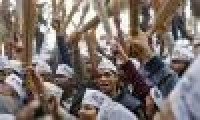Horse race journalism
Horse race coverage is fuelled by a growth in political polling. There are strong news industry compulsions for adopting this mode of election reporting.
But it is significant for what it lets fall by the wayside, says SEVANTI NINAN

TALKING MEDIA
Sevanti Ninan
When both political parties and the media turn an Indian election into a US-style presidential one, its natural corollary will be what the Americans call horse race journalism. What we saw for most of the six-month run-up to the finale of these general elections conforms to this genre. To read any description of its characteristics is to instantly recognize what we witnessed here this time around.
It is journalism which foregrounds personalities over policy positions, indeed focusing almost exclusively on the chances of one over the other. To be fair, Narendra Modi’s personality build-up was initially predicated on his policy or governance strategy positions, because that is how he projected himself. But once that became covered territory, the daily campaign news focused on how his cult was growing to the detriment of rivals. The kind of tireless campaign Modi ran only fed into this kind of projection.
Horse race coverage is fuelled by a growth in political polling. Earlier Indian elections have had a shorter countdown period and had much fewer rounds of polling. This time there were multiple polls. Constant measuring of who is ahead, or who is gaining, focuses on personality and performance, and fills many hours of studio talk-time with speculative chatter. Polls replaced location reporting on TV. Which too, in good horse race tradition, became confined to key constituencies. Between Varanasi, Amritsar and Amethi there was room for little else.
There are strong news industry compulsions for adopting this mode of election reporting. There is more media now than there was, say in 2009, chasing less money in the news business. Tackling competition on tight budgets leads television in particular to seize upon a candidate-led contest as a godsend. Particularly when the lead candidate is so well-backed with resources that even your needs for daily footage are efficiently taken care of by his machine.
The pattern may not have been as sharply recognizable in 2009, but is unmissable in 2014. Back then, the meat of the contest centred less on personality than programme. It wasn’t primarily a Manmohan Singh–L.K. Advani face-off, nor was there a third horse in the race. Or rather the third horse was the Third Front, not a personality like Arvind Kejriwal.
If Indian coverage in this election was coded and measured in both TV and print stories, we would know what category of stories came to dominate this election. That kind of research is increasingly needed and one college department is working on it this time. All the controversies that bubbled up in the course of a long election campaign fed into the competition and clash between personalities. That includes name-calling we saw the campaign degenerate into, the focus on the campaign machinery and lieutenants of the leading candidate, and on the more telegenic campaigners for his chief rival.
The focus on daily interviews with Modi and Amit Shah in the concluding weeks of the campaign was essentially calibrated by them. By then the media was eating out of their hands. The winning horse was running away with the coverage. Even if he had problems with some of it. In the course of an entire speech the media will focus its energy only on the one comment that suits its purpose, Modi told Times Now.
Horse race journalism is significant for what it lets fall by the wayside. The comparative policy positions of the lead candidates, for one. Going out and listening to the electorate, for another. Paying enough attention to those like Mayawati who do not court the media, for a third. If Shah’s estimate (published on Wednesday) that Mayawati's Bahujan Samaj Party will get the second highest number of seats in Uttar Pradesh comes true, it will further expose the inadequacies of the coverage television did.
Because in this the invisible horse does not get factored in enough. There is room in a TV poll to put effective focus only on a few of top players, and then, explaining is not the medium’s forte. You had to turn to The Indian Express to understand the paradox of Nitish Kumar’s good work going against him.
A scholar studying this phenomenon has argued that the constant emphasis on polls and what they are showing begins to shape how consumers of TV and print begin to think of candidates. There is a shift from what does he/she stand for, to winnability—which of them is going to win?
One tragedy of this election’s coverage was that in obsessing about the contest, journalists lost interest in the idea of the Aam Aadmi Party. Its leader simply became the competing horse in a much-watched race, no longer the harbinger of a new force in Indian politics.
The irony of this horse race business also is that the media begins to believe it is central to a poll outcome, that the storm of ceaseless coverage is creating interest, driving the turnout and the candidates’ fortunes. In the final analysis that may turn out to be a serious overestimate.
Reprinted from Mint May 15, 2014